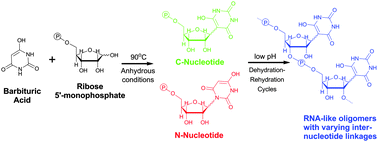Synthesis of barbituric acid containing nucleotides and their implications for the origin of primitive informational polymers†
Abstract
Given that all processes in modern biology are encoded and orchestrated by polymers, the origin of informational molecules had to be a crucial and significant step in the origin of life on Earth. An important molecule in this context is RNA that is thought to have allowed the transition from chemistry to biology. However, the RNA molecule is comprised of intramolecular bonds which are prone to hydrolysis, especially so under the harsh conditions of the early Earth. Furthermore, the formation of nucleotides with extant bases and their subsequent polymerization have both been problematic, to say the least. Alternate heterocycles, in contrast, have resulted in nucleosides in higher yields, suggesting a viable and prebiotically relevant solution to the longstanding “nucleoside problem”. In the present study, we have synthesized a nucleotide using ribose 5′-monophosphate (rMP) and barbituric acid (BA), as the base analog, using dry-heating conditions that are thought to be prevalent in several regimes of the early Earth. Polymerization of the resultant monomers, i.e. BA-nucleotides, was also observed when dehydration–rehydration cycles were carried out at low pH and high temperature. The resulting RNA-like oligomers have intact bases unlike in reactions that were carried out with canonical nucleotides, which resulted in abasic sites under acidic conditions due to cleavage of the N-glycosidic linkages. Furthermore, the incorporation of BA directly into preformed sugar–phosphate backbones was also observed when rMP oligomers were subjected to heating with BA. The results from our aforementioned experiments provide preliminary evidence that BA could have been a putative precursor of modern nucleobases, which could have been incorporated into primitive informational polymers that predated the molecules of an RNA world. Moreover, they also highlight that the prebiotic soup, which would have been replete with alternate heterocycles, could have allowed the sampling of other such heterocycles, which would have had a selective advantage under pertinent selection pressures. Importantly, these kinds of processes have implications for shaping the prebiotic landscape that allowed for the emergence of primitive informational polymers of the pre-RNA world(s), prior to the emergence of a putative RNA world.

- This article is part of the themed collection: Prebiotic chemistry and the molecular origins of life

 Please wait while we load your content...
Please wait while we load your content...